Simulating Human Visual Perception in Tunnel Portals
Abstract
1. Introduction
2. Materials and Methods
2.1. Experimental Elements
2.2. Observers
2.3. Experimental Setup
- Light-shielded tent (see Figure 2a): The dark environment inside a tunnel was simulated with the tent, with a height of 3.0 m, a length of 8.0 m, and a width of 4.0 m. The illuminance ranged from 40~520 lux in the tent.
- Digital illuminance meter (see Figure 2b): The ambient illuminance was measured with a TES-1339, and the measurement illuminance range was 0.0–990,000 lux, while the resolution was 0.01 lux. The measurement accuracy was ± 3%.
- Camera (see Figure 2c): The adaptation time of the observers was recorded upon entering and leaving the simulated tunnel.
- Test board and card: The test board was 1.2 m high. There were 20 test cards, including simple Chinese characters and animal images, with a size of 0.15 × 0.15 m. The distance between the observer and the test card was 60–80 cm, which allowed the graphic elements to be identified.
- Car: A noisy environment was simulated.
2.4. Experimental Procedure
- Step 1. Ambient illuminance measurement
- Step 2. Dark adaptation time measurement
- Step 3. Light adaptation time measurement
2.5. Experimental Design
2.6. Experimental Error Control
3. Results and Discussion
3.1. Comparative Analysis of the Light and Dark Adaptation Times
3.2. Characteristics of Light and Dark Adaptation Based on Age
3.2.1. Correlation Analysis for Adaptation Time and Age
- The dark adaptation Rs value is 0.805, and the p value is below the theoretical significance level of 0.01, indicating that the dark adaptation time exhibited a significant positive correlation with age.
- The light adaptation Rs value is 0.079, which indicated that there was no significant correlation between the light adaptation time and age.
3.2.2. Establishing the Relationship between Dark Adaptation Time and Age
- Dark adaptation time and age generally exhibited a cubic correlation; i.e., the dark adaptation time generally increased with increasing age.
- Equation (2) confirmed statistical significance.
- The dark adaptation time was generally shorter than 4.0 s, and most values were concentrated between 1.2 and 2.4 s.
3.2.3. Analysis of the Relationship between Light Adaptation Time and Age
- There were large individual differences in light adaptation time, and there was no clear correlation with age, but the overall trend was a gradual increase with increasing age.
- The light adaptation time was generally shorter than 2.0 s, and most light adaptation times ranged from 0.7 to 1.5 s.
3.3. Characteristics of Light and Dark Adaptation Based on Gender
3.4. Characteristics of Light and Dark Adaptation Based on Illuminance
3.4.1. Analysis of the Relationship between Adaptation Time and Illuminance
3.4.2. Establishing the Relationship between Adaptation Time and Illuminance
- Figure 18 shows that at the same illuminance, the dark adaptation time is longer than the light adaptation time, which is consistent with the previous analysis results.
- Illuminance directly affects the dark and light adaptation times, and they generally have cubic relations.
- Equations (3) and (4) confirm statistical significance.
4. Conclusions and Future Work
- After a driver enters or exits a tunnel, a certain vision adaptation time is required, because of drastic changes in the light environment. This is because the pupil changes the intensity of the light [9]: when entering the tunnel, the light will darken, the pupil will enlarge, and the eye will see black; when leaving the tunnel, the light will become bright, the pupil will contract and the eye will see white. This is also the reason why there are more accidents at tunnel entrances than on ordinary road sections [8].
- The experimental results indicate that the dark and light adaption times ranged from 1.2 to 2.4 s and 0.7 to 1.5 s, respectively. The adaptation times for dark and light were slightly longer than those of 2.3 and 1.3 s in [10], but the conclusions were similar overall. Under all illuminance conditions, the dark adaptation time was longer than the light adaptation time, indicating that the visual discomfort for drivers caused by a tunnel entrance is more severe than that caused by a tunnel exit, i.e., the black hole effect is more dangerous than the white hole effect. With increasing age, the difference between the light and dark adaptation times increases.
- Experiment 1 showed that there was a significant positive correlation between dark adaptation time and age; namely, with increasing driver age, the dark adaptation time increased, while the correlation between light adaptation time and age was not significant. The main reason for this [4,14] is that the elderly need a longer fixation time, and the efficiency of visual information processing is reduced.
- Under different age and illuminance conditions, the adaptation time remained generally the same regardless of gender. It can be concluded that there is no correlation between gender and light and dark adaptation times.
- Dark adaptation time was highly correlated with illuminance. Light and dark adaptation times increased with increasing illuminance, reaching maximum values from 12,000 to 13,000 lux and from 11,000 to 12,000 lux, respectively. When the illuminance continued to increase, the adaptation time gradually decreased with increasing illuminance, but the downward trend was slower than the upward trend.
Author Contributions
Funding
Institutional Review Board Statement
Informed Consent Statement
Data Availability Statement
Acknowledgments
Conflicts of Interest
References
- Van Winsum, W. The effects of cognitive and visual workload on peripheral detection in the detection response task. Hum. Factors 2018, 61, 992–1003. [Google Scholar] [CrossRef]
- Narisada, K.; Yoseoikawa, K. Tunnel entrance lighting-effect of fixation point and other factors on the determination of requirements. Lighting Res. Technol. 1974, 6, 9–18. [Google Scholar] [CrossRef]
- Zwahlen, H.T. Driver eye scanning behavior at tunnel approaches: Executive summary and technical report. Report Frankl. Inst. Res. Cab. 1979, 1, 2–12. [Google Scholar]
- Maltz, M.; Shinar, D. Eye movements of younger and older drivers. Hum. Factors J. Hum. Factors Ergon. Soc. 1999, 41, 15–25. [Google Scholar] [CrossRef] [PubMed]
- Underwood, G.; Phelps, N.; Wright, C.; Loon, E.V.; Galpin, A. Eye fixation scanpaths of younger and older drivers in a hazard perception task. Ophthalmic Physiol. 2005, 25, 346–356. [Google Scholar] [CrossRef] [PubMed]
- Crundall, D.E.; Underwood, G. Affects of experience: And processing demands on visual information acquisition in drivers. Ergonomics 1998, 41, 448–458. [Google Scholar] [CrossRef]
- Ito, H.; Sato, M.; Oshima, A. Estimation of the Critical Luminance Contrast in Tunnel Interior Lighting. J. Illum. Eng. Inst. Jpn. 2009, 93, 77–83. [Google Scholar] [CrossRef][Green Version]
- Liu, Y. Light Environment Analysis of Highway Tunnel Based on Driver’s Physiological and Psychological Response; School of Energy and Transportation Engineering, Inner Mongolia Agricultural University: Hohhot, China, 2009; pp. 53–55. [Google Scholar]
- Du, Z.; Pan, X.; Yang, Z. Research on visual turbulence and driving safety of freeway tunnel entrance and exit. China J. Highw. Transp. 2007, 2, 101–105. [Google Scholar]
- Du, Z.; Huang, F.; Yan, X.; Pan, X. Light and Dark Adaption Times Based on Pupil Area Variation at Entrance and Exit Areas of Highway Tunnels. J. Highw. Transp. Res. Dev. 2014, 30, 98–102. [Google Scholar] [CrossRef]
- Hu, Y.; Chen, Z.; Sun, C. Calculation Method of Road Tunnel Threshold Zone Luminance Based on Equivalent Veiling Luminance. J. Highw. Transp. Res. Dev. 2011, 28, 98–101. [Google Scholar] [CrossRef]
- Hu, Y.; Chen, X.; Zhang, Q.; Wen, J. Drivers’ adaptation luminance changing rule when driving into tunnels. J. Chongqing Univ. 2016, 39, 99–104. [Google Scholar] [CrossRef]
- Hu, J.B.; Ma, W.Q. Threshold Zone Light Environment of Tunnel Based on Driving Visual Demand. J. Shanghai Jiaotong Univ. 2015, 49, 464–469. [Google Scholar] [CrossRef]
- Huang, F. Experimental Study on Improvement of Road Driver’s Optical Illusion Based on “Black Hole Effect”; Wuhan University of Technology: Wuhan, China, 2014; pp. 53–55. [Google Scholar]
- Mehri, A.; Hajizadeh, R.; Dehghan, S.F.; Nassiri, P.; Jafari, S.M.; Taheri, F.; Zakerian, S.A. Safety Evaluation of the Lighting at the Entrance of a Very Long Road Tunnel: A Case Study in Ilam. Saf. Health Work 2017, 8, 151–155. [Google Scholar] [CrossRef]
- Duan, M.; Tang, B.; Hu, X.; He, B. Driver’s Visual Load at Tunnel Entrance and Exit of Sections with High Ratio of Tunnels. J. Transp. Syst. Eng. Inf. Technol. 2018, 18, 113–119. [Google Scholar]
- Chen, Y.; Du, Z.; Jiao, F. Research on Visual Loads of Different Vehicle Types in Short Tunnel Entrance Section of Small Radius Highway. J. Wuhan Univ. Technol. 2019, 43, 709–711. [Google Scholar]
- Zheng, G.P.; Tian, W.; Sun, Y. Influence of tunnel lighting system installation modes and parameters on energy saving. In IOP Conference Series: Earth and Environmental Science; IOP Publishing: Bristol, UK, 2020; Volume 601, p. 1. [Google Scholar] [CrossRef]
- Takemura, Y.; Ito, M.; Shimizu, Y.; Okano, K.; Okano, T. Adaptive light: A lighting control method aligned with dark adaptation of human vision. Sci. Rep. 2020, 10, 11204. [Google Scholar] [CrossRef]
- Zhao, E.N.; Dong, L.L.; Chen, Y.; Lou, Q.; Xu, W.H. The Impact of LED Color Rendering on the Dark Adaptation of Human Eyes at Tunnel Entrances. Int. J. Environ. Res. Public Health 2020, 17, 1566. [Google Scholar] [CrossRef] [PubMed]
- Dong, L.; Shang, X.; Zhao, Y.; Qin, L.; Xu, W. The Impact of LED Light Color on the Dark Adaptation of Human Vision in Tunnel Entrances. IEEE Photonics J. 2019, 99, 1–11. [Google Scholar] [CrossRef]
- Du, Z.; Huang, F.; Ran, B.; Pan, X. Safety Evaluation of Illuminance Transition at Highway Tunnel Portals on Basis of Visual Load. Transp. Res. Rec. 2018, 47–62. [Google Scholar] [CrossRef]
- Zhou, N.; Dong, W.; Wang, J.; Paul, J.C. Simulating human visual perception in nighttime illumination. Tsinghua Sci. Technol. 2009, 14, 133–138. [Google Scholar] [CrossRef]
- Jing, Q.C.; Ji, G.P. Human Vision; Science Press: Beijing, China, 2019; pp. 5–7. [Google Scholar]
- Durso, F.T.; Delucia, P.R.; Jones, K.S. Engineering Psychology; Wiley: New York, NY, USA, 2010; pp. 123–126. [Google Scholar]
- Lokka, E.; Çöltekin, A. Perspective switch and spatial knowledge acquisition: Effects of age, mental rotation ability and visuospatial memory capacity on route learning in virtual environments with different levels of realism. Cartogr. Geogr. Inf. Sci. 2019, 47, 14–27. [Google Scholar] [CrossRef]
- Keil, J.; Edler, D.; O’Meara, D.; Korte, A.; Dickmann, F. Effects of Virtual Reality Locomotion Techniques on Distance Estimations. ISPRS Int. J. Geo-Inf. 2021, 10, 150. [Google Scholar] [CrossRef]
- Angel, P.; Kamen, G.; Marin, D. Optimizing the levels of group dimming of luminaires for adaptation tunnel lighting. In Proceedings of the 2019 Second Balkan Junior Conference on Lighting (Balkan Light Junior), Plovdiv, Bulgaria, 19–21 September 2019. [Google Scholar]
- Zhang, R.; Huang, X.; Zhao, Y.; Gao, Y. Investigation and Analysis of Tunnel Noise. J. Highw. Transp. Res. Dev. 2006, 108, 19–22. [Google Scholar] [CrossRef]
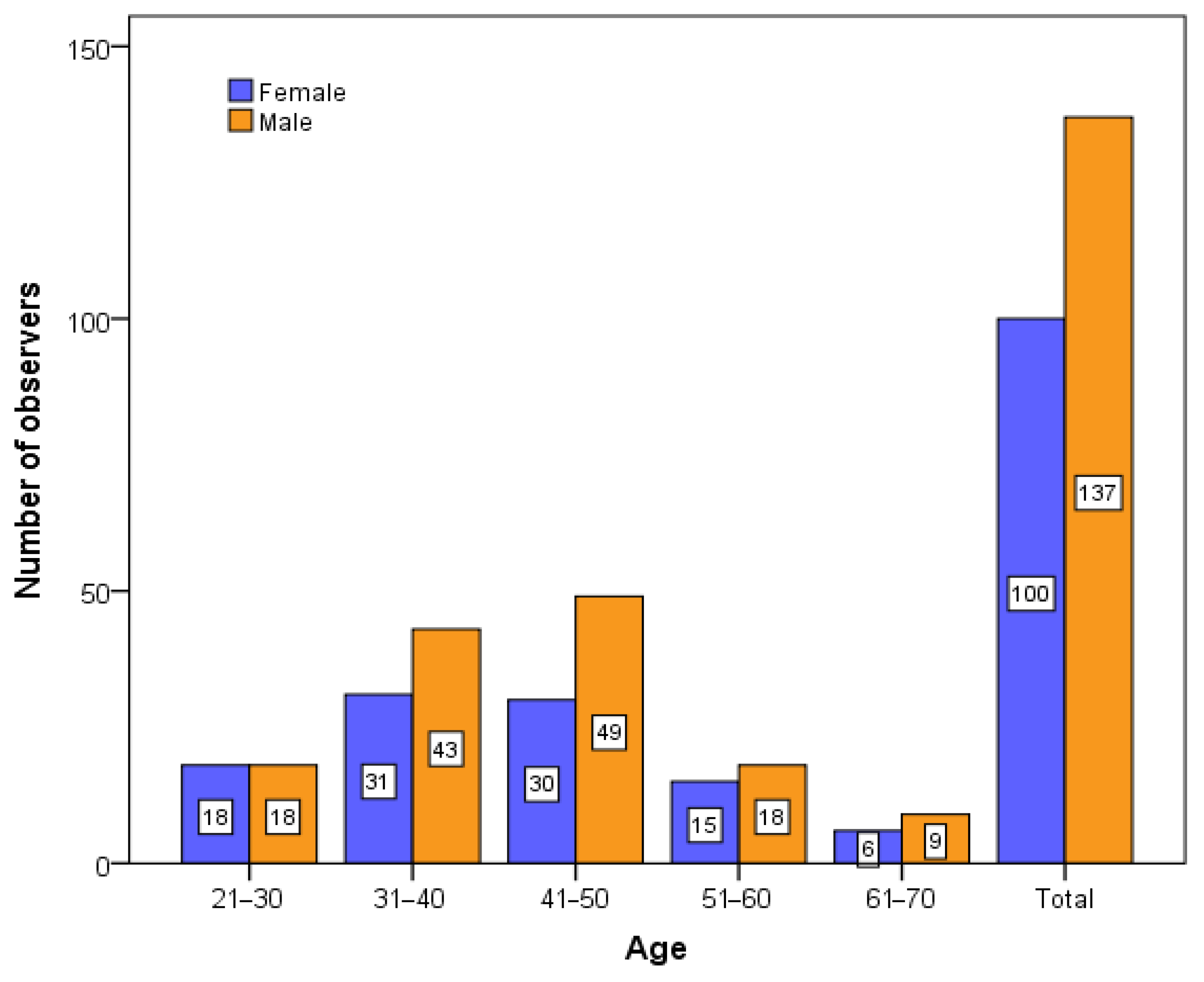

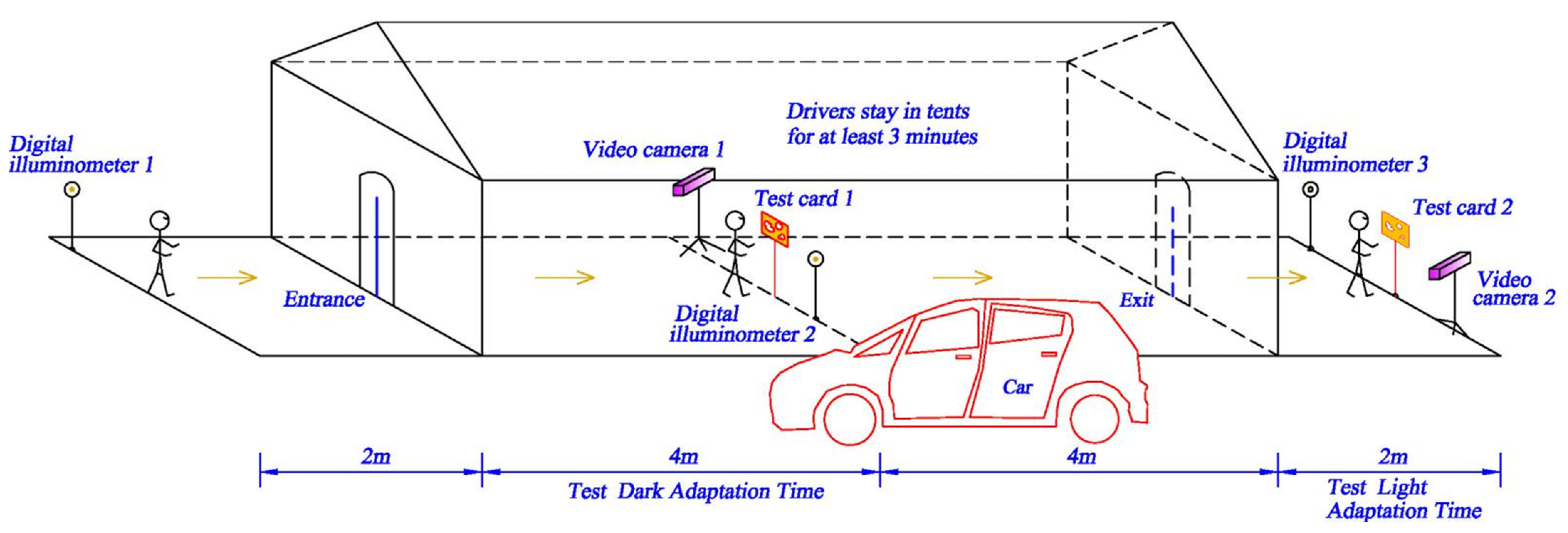
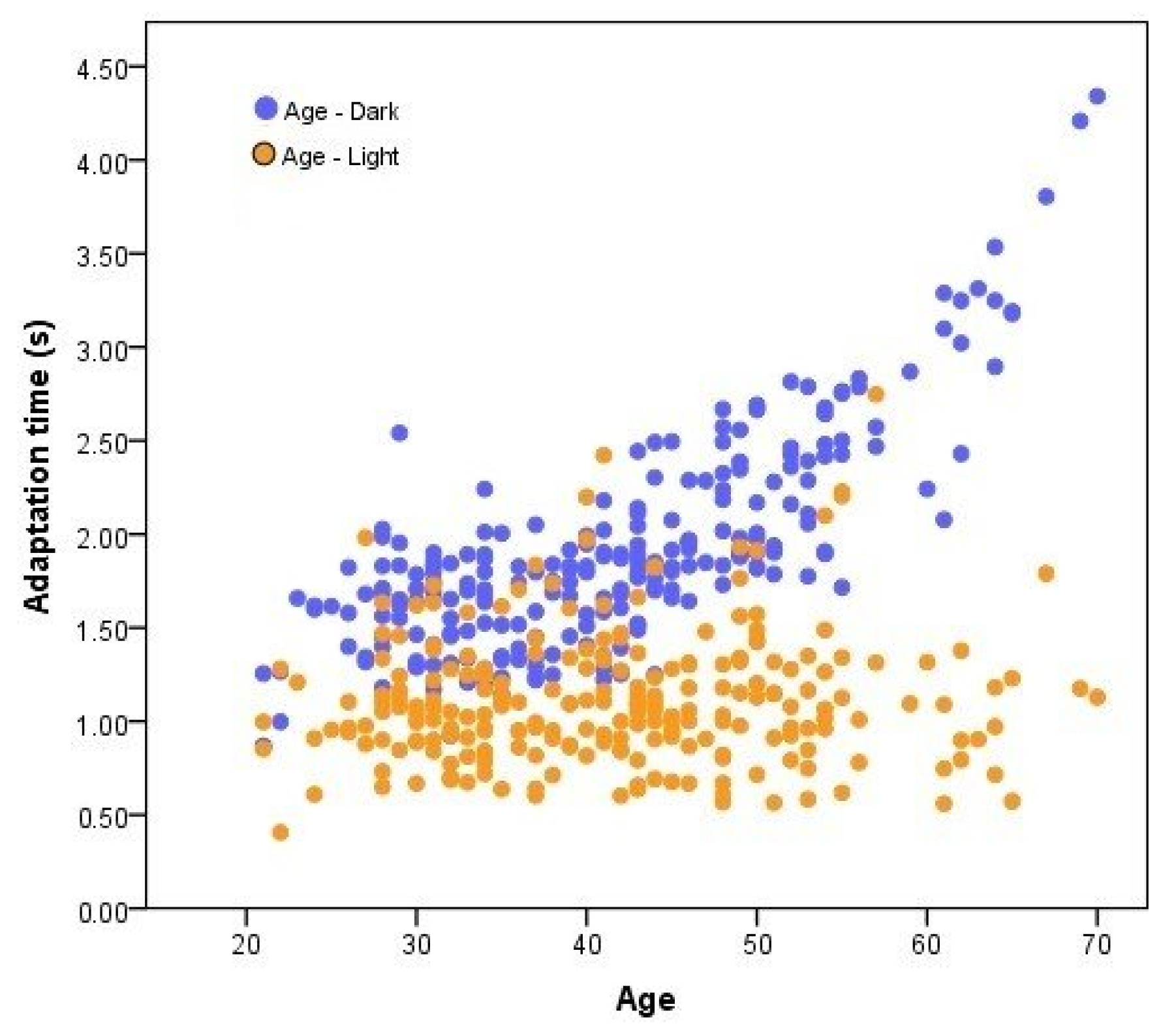


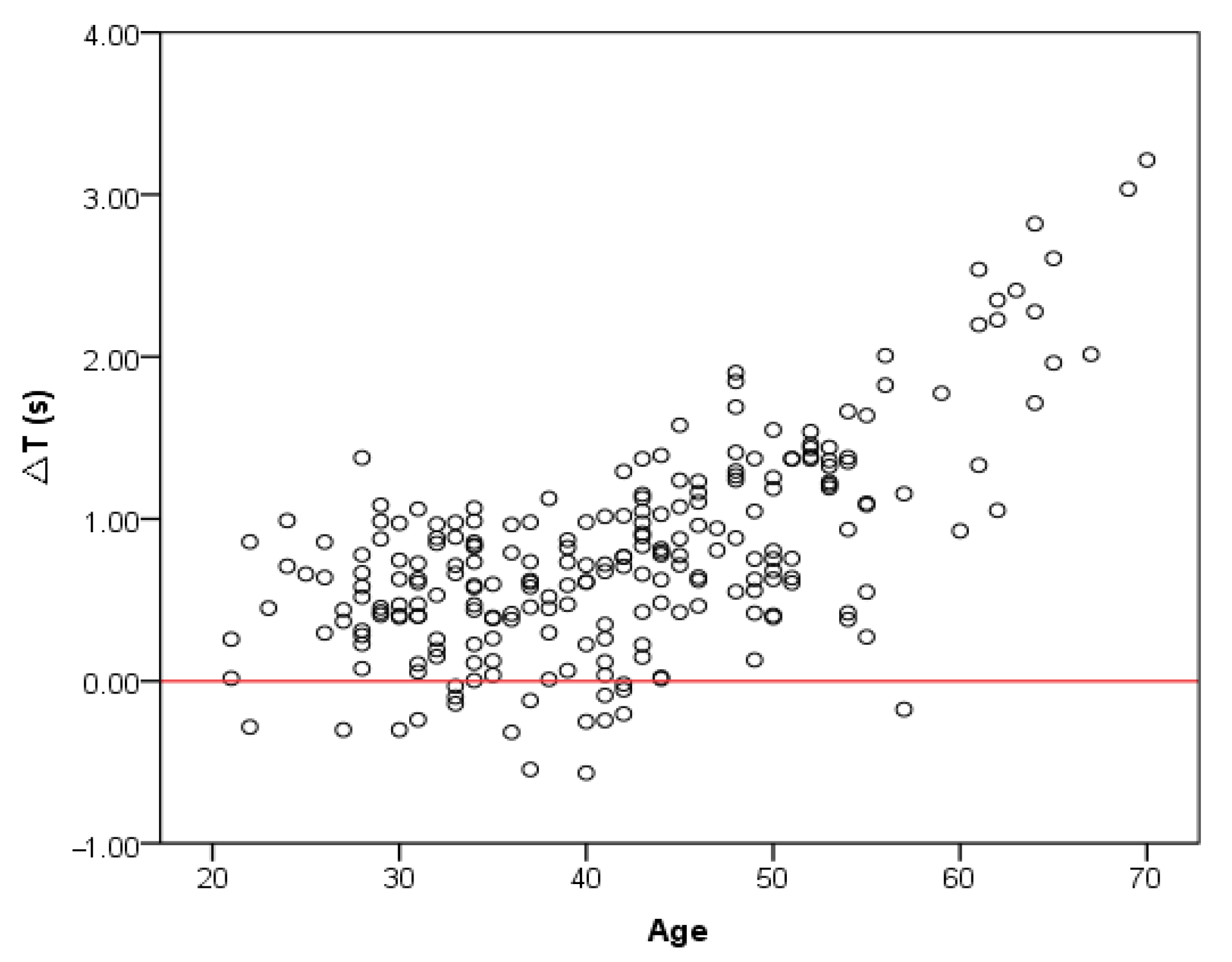




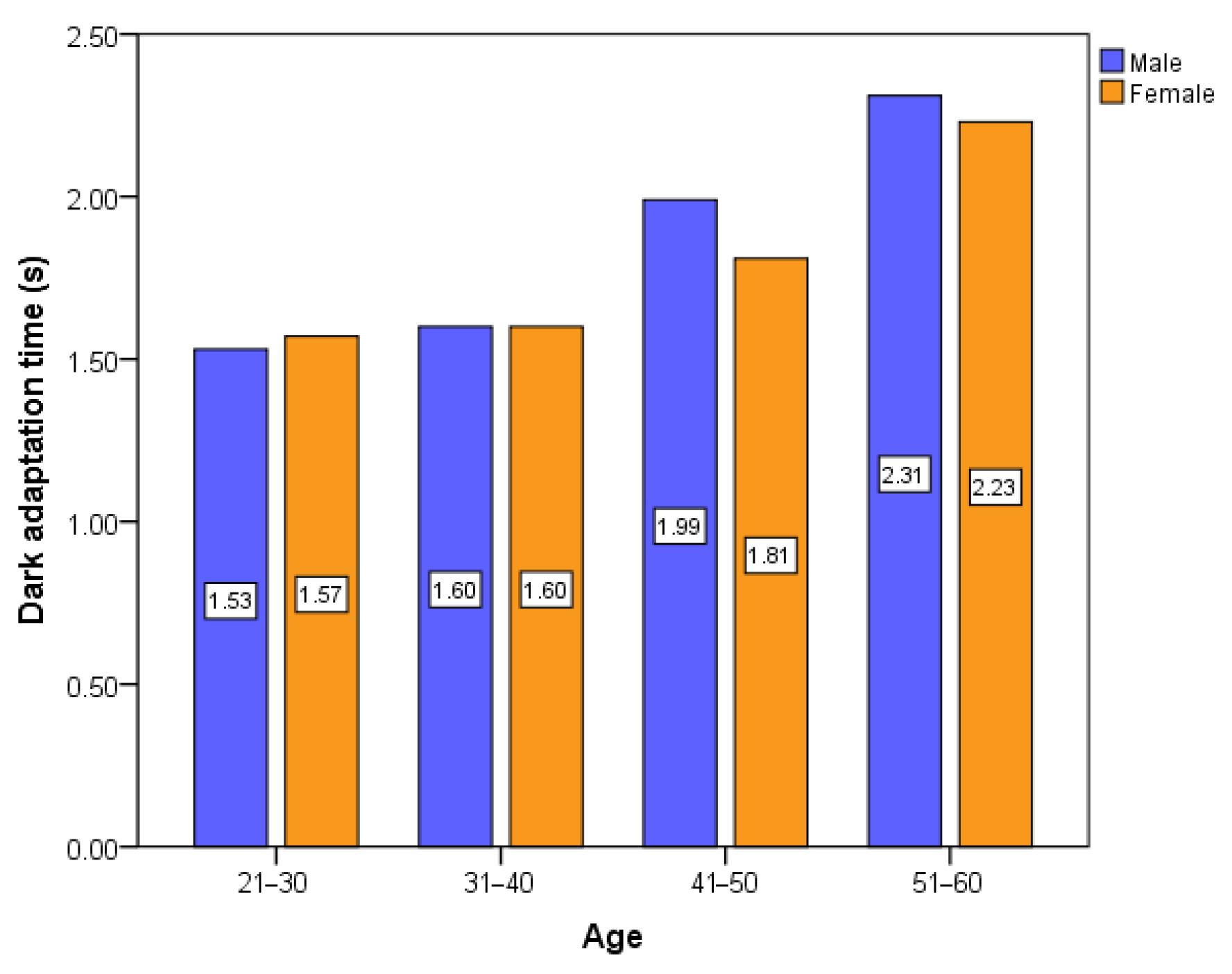
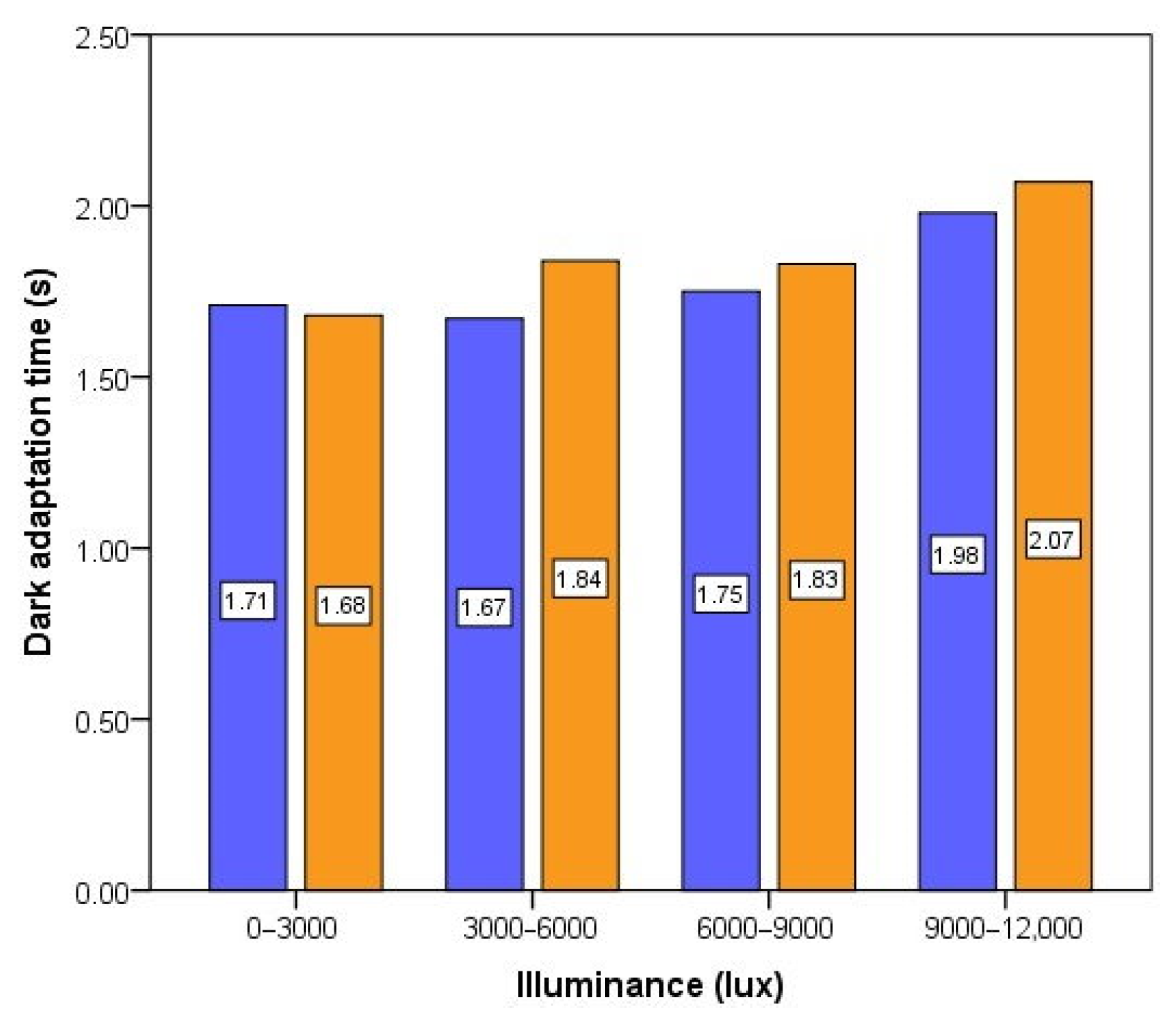


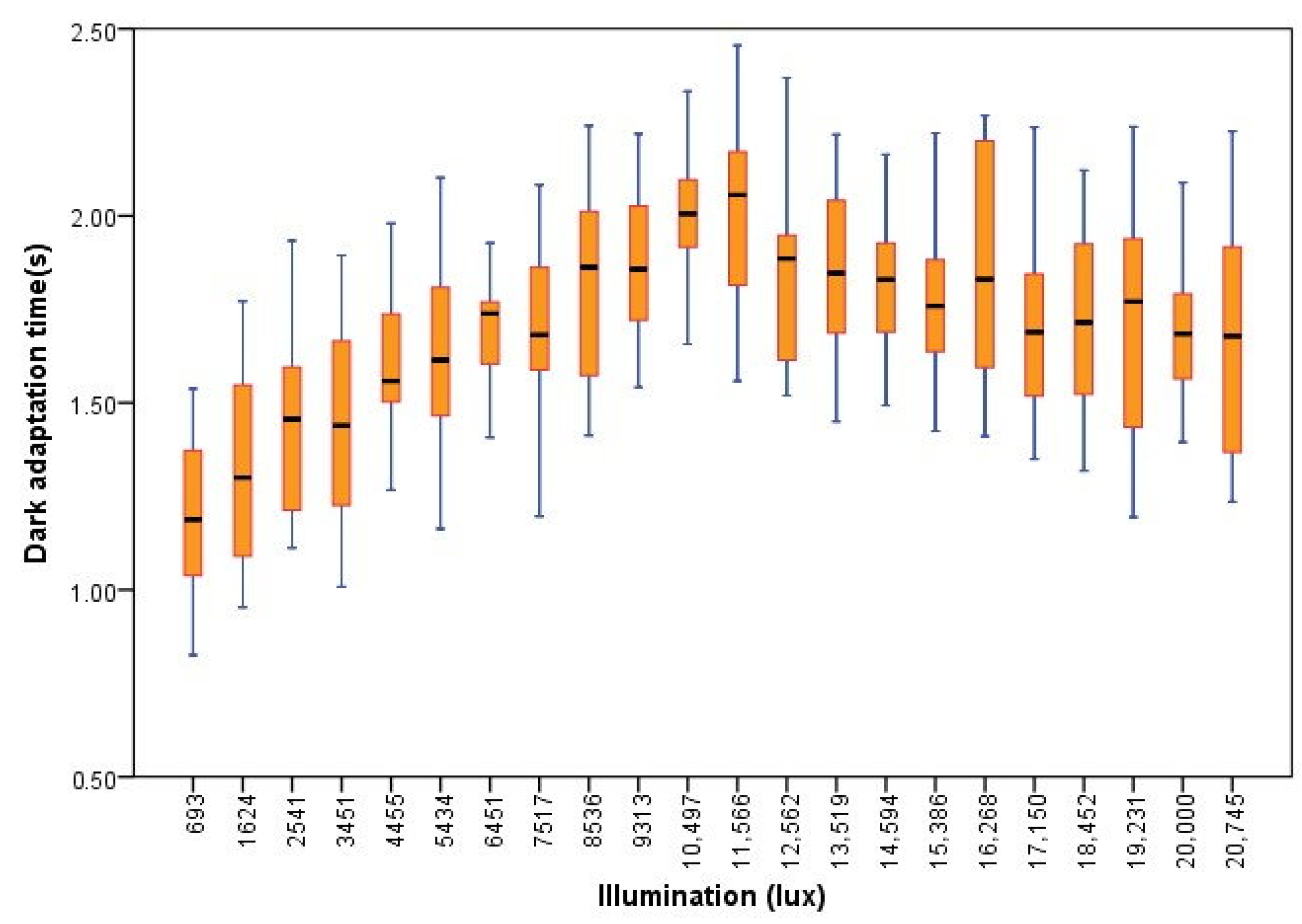


| Type | N | Spearman Correlation Coefficient Rs | Significance p |
|---|---|---|---|
| Dark adaptation | 187 | 0.805 1 | ≤0.001 |
| Light adaptation | 187 | 0.079 | 0.283 |
| Model | R | R2 | Adjusted R2 | Standard Error |
|---|---|---|---|---|
| Cubic term | 0.862 | 0.743 | 0.738 | 0.283 |
| Type | Non-Standardized Coefficients | Standardized Coefficients | T | Significance p | |
|---|---|---|---|---|---|
| B | Standard Error | Beta | |||
| a | 0.092 | 0.067 | 1.780 | 1.386 | 0.167 |
| a2 | −0.003 | 0.002 | −4.210 | −1.626 | 0.106 |
| a3 | 2.819 × 10−5 | 0.000 | 3.357 | 2.450 | 0.015 |
| Comments | 0.226 | 0.921 | 0.245 | 0.807 | |
| Type | Sum of Squares | Degrees of Freedom (df) | Mean Squared Error | F | Significance p |
|---|---|---|---|---|---|
| Between Groups | 42.297 | 3 | 14.099 | 175.971 | ≤0.001 |
| Within Groups | 14.662 | 183 | 0.080 | ||
| Total | 56.959 | 186 |
| Type | R | R2 | Adjusted R2 | Standard Error |
|---|---|---|---|---|
| Dark adaptation | 0.960 | 0.922 | 0.909 | 0.061 |
| Light adaptation | 0.958 | 0.919 | 0.905 | 0.039 |
| Type | Sum of Squares | df | Mean Squared Error | F | Significance p | |
|---|---|---|---|---|---|---|
| Light adaptation time | Between groups | 0.787 | 3 | 0.262 | 70.923 | ≤ 0.001 |
| Within groups | 0.067 | 18 | 0.004 | |||
| Total | 0.854 | 21 | ||||
| Dark adaptation time | Between groups | 0.309 | 3 | 0.103 | 67.756 | ≤ 0.001 |
| Within groups | 0.027 | 18 | 0.002 | |||
| Total | 0.337 | 21 | ||||
Publisher’s Note: MDPI stays neutral with regard to jurisdictional claims in published maps and institutional affiliations. |
© 2021 by the authors. Licensee MDPI, Basel, Switzerland. This article is an open access article distributed under the terms and conditions of the Creative Commons Attribution (CC BY) license (http://creativecommons.org/licenses/by/4.0/).
Share and Cite
Liu, C.; Wang, Q. Simulating Human Visual Perception in Tunnel Portals. Sustainability 2021, 13, 3741. https://doi.org/10.3390/su13073741
Liu C, Wang Q. Simulating Human Visual Perception in Tunnel Portals. Sustainability. 2021; 13(7):3741. https://doi.org/10.3390/su13073741
Chicago/Turabian StyleLiu, Changjiang, and Qiuping Wang. 2021. "Simulating Human Visual Perception in Tunnel Portals" Sustainability 13, no. 7: 3741. https://doi.org/10.3390/su13073741
APA StyleLiu, C., & Wang, Q. (2021). Simulating Human Visual Perception in Tunnel Portals. Sustainability, 13(7), 3741. https://doi.org/10.3390/su13073741






